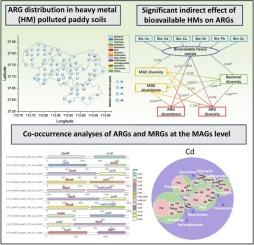Significant effects of bioavailable heavy metals on antibiotic resistome in paddy soils as revealed by metagenomic analysis
IF 12.2
1区 环境科学与生态学
Q1 ENGINEERING, ENVIRONMENTAL
引用次数: 0
Abstract
Heavy metals (HMs) act as a long-term selective pressure for the emergence and maintenance of antibiotic resistance genes (ARGs) in agricultural soils. However, the effects of HMs on ARG distributions in paddy soils and the underlying mechanisms remain unclear. In this study, 74 soil samples were collected from the paddy fields to explore the impact of HMs on ARG profiles. A total of 468 ARGs were detected in HM-contaminated soils. Variation partitioning analysis (VPA) and redundancy analysis (RDA) demonstrated that the bioavailable HMs contributed more significantly to ARG composition compared to the total HM content (8.59% vs. 3.97%). Structural equation models (SEMs) showed that bioavailable HMs affected ARGs mainly by negatively altering the microbial diversity. Furthermore, the co-occurrence analysis of ARGs and metal resistant genes (MRGs) was further performed at the metagenome-assembled genomes (MAGs) level. Consequently, 1145 MAGs that assigned to 29 bacterial phyla were found to concurrently harbor ARG and MRG, with the bacterial phyla Pseudomonadota being predominant ARG-MRG-carrying microbes for most coexistence types of ARGs and MRGs, i.e., multidrug-As, polymyxin-Cd, Quinolone-Cd, Beta-lactam-Pb, and multidrug-Zn. Our findings highlight that the extensive coexistence of ARG-MRG in microbial genomes is an important reason for the ARG pollution in HM-contaminated paddy soils.

元基因组分析揭示的生物可利用重金属对稻田土壤抗生素耐药性组的显著影响
重金属(HMs)是农业土壤中抗生素抗性基因(ARGs)出现和维持的长期选择性压力。然而,HMs 对水稻田土壤中 ARG 分布的影响及其内在机制仍不清楚。本研究从稻田中采集了 74 份土壤样本,以探讨 HMs 对 ARG 特征的影响。在受 HM 污染的土壤中,共检测到 468 种 ARGs。变异分区分析(VPA)和冗余分析(RDA)表明,与 HM 总含量相比,生物可利用的 HM 对 ARG 组成的影响更大(8.59% 对 3.97%)。结构方程模型(SEM)表明,生物可利用的 HMs 主要通过负面改变微生物多样性来影响 ARG。此外,还进一步在元基因组组装基因组(MAGs)水平上对 ARGs 和抗金属基因(MRGs)进行了共现分析。结果发现,29个细菌门的1145个MAGs同时携带ARG和MRG,其中假单胞菌门是大多数ARG和MRG共存类型(即多药-As、多粘菌素-Cd、喹诺酮-Cd、β-内酰胺-Pb和多药-Zn)的主要ARG-MRG携带微生物。我们的研究结果表明,微生物基因组中 ARG-MRG 的广泛共存是造成 HM 污染稻田土壤中 ARG 污染的一个重要原因。
本文章由计算机程序翻译,如有差异,请以英文原文为准。
求助全文
约1分钟内获得全文
求助全文
来源期刊

Journal of Hazardous Materials
工程技术-工程:环境
CiteScore
25.40
自引率
5.90%
发文量
3059
审稿时长
58 days
期刊介绍:
The Journal of Hazardous Materials serves as a global platform for promoting cutting-edge research in the field of Environmental Science and Engineering. Our publication features a wide range of articles, including full-length research papers, review articles, and perspectives, with the aim of enhancing our understanding of the dangers and risks associated with various materials concerning public health and the environment. It is important to note that the term "environmental contaminants" refers specifically to substances that pose hazardous effects through contamination, while excluding those that do not have such impacts on the environment or human health. Moreover, we emphasize the distinction between wastes and hazardous materials in order to provide further clarity on the scope of the journal. We have a keen interest in exploring specific compounds and microbial agents that have adverse effects on the environment.
 求助内容:
求助内容: 应助结果提醒方式:
应助结果提醒方式:


